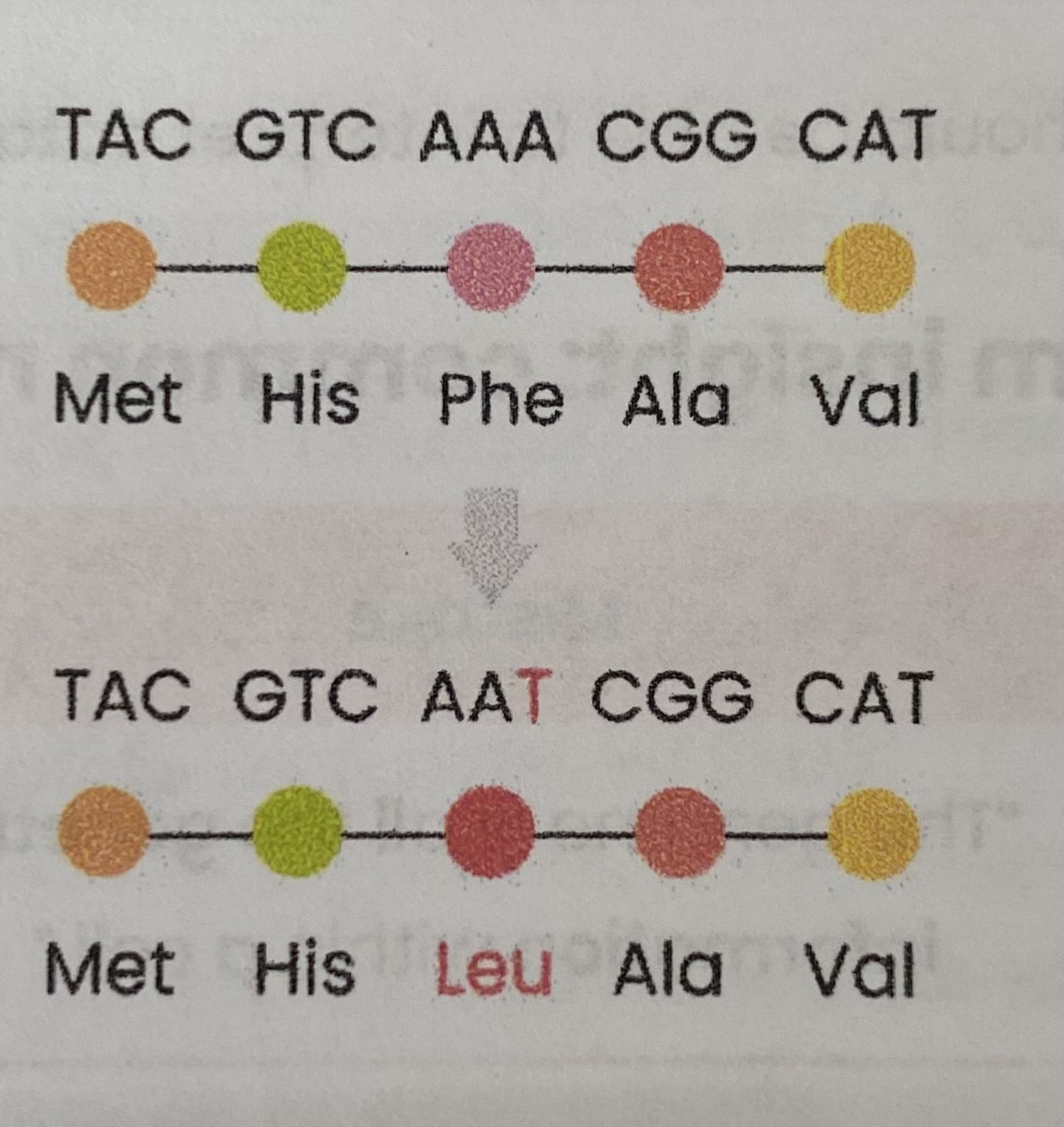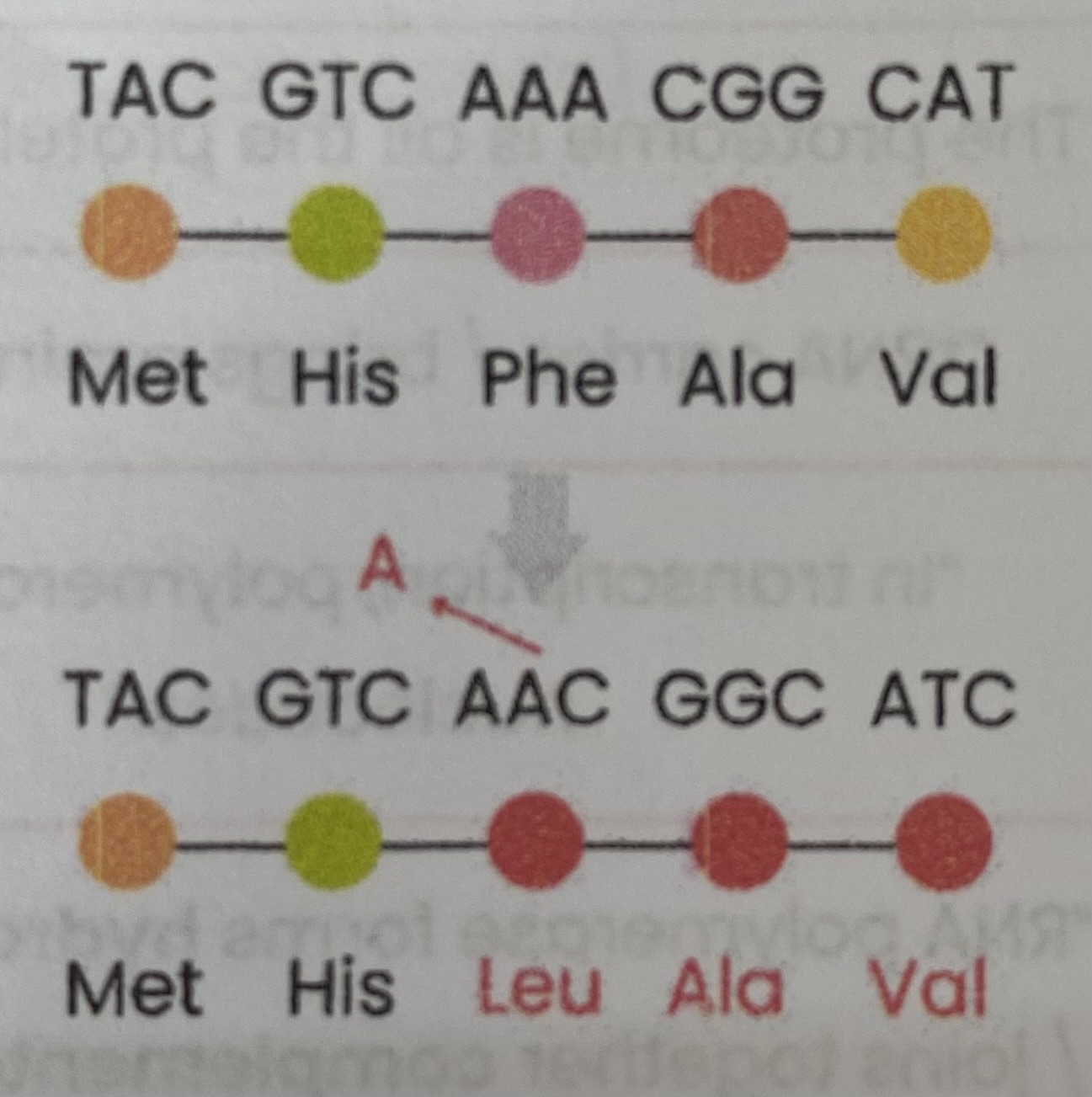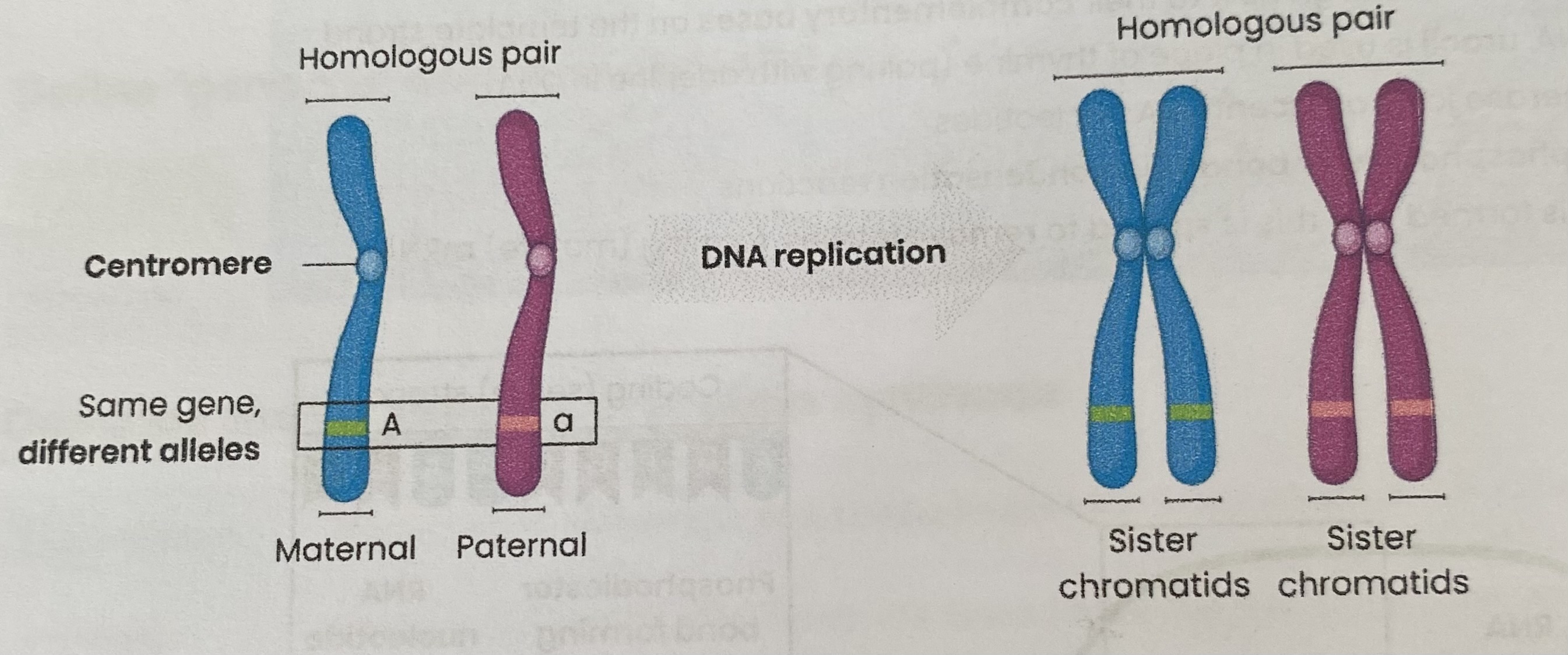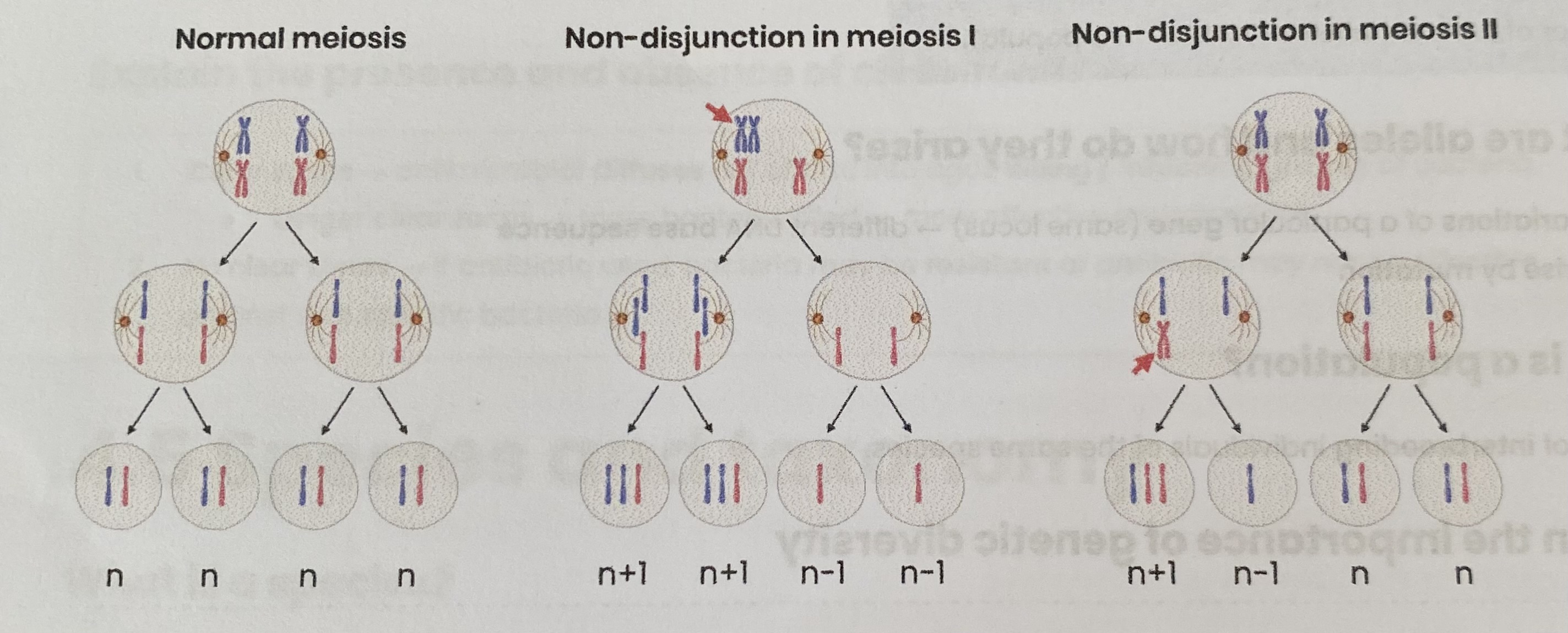4- Genetic diversity, meiosis, adaptation, RP6
1/50
There's no tags or description
Looks like no tags are added yet.
Name | Mastery | Learn | Test | Matching | Spaced |
|---|
No study sessions yet.
51 Terms
What is a gene mutation?
A change in the base sequence of DNA (on chromosomes)
can arise spontaneously during DNA replication (interphase)
What is a mutagenic agent?
A factor that increases rate of gene mutation, e.g. ultraviolet (UV) light or alpha particles
Explain how a mutation can lead to the production of a non-functional protein or enzyme
Changes sequence of base triplet in DNA (in a gene) so changes sequence of codons on mRNA
so changes sequence of amino acids in the polypeptide
so changes position of hydrogen/ ionic/ disulphide bonds (between amino acids)
so changes protein tertiary structure (shape) of protein
Enzymes- active site changes shape so substrate can’t bind, enzyme-substrate complex can’t form
Explain the possible effects of a substitution mutation
Base/ nucleotide in DNA replaced by a different base/ nucleotide
This changes one triplet so changes one mRNA codon
so 1 amino acid in polypeptide changes
tertiary structure may change if position of hydrogen/ ionic/ disulphide bonds change
OR amino acid doesn’t change
due to degenerate nature of genetic code (triplet could code for same amino acid) OR if mutation is in an intron

Explain the possible effects of a deletion mutation
One nucleotide/ base removed from DNA sequence
Changes sequence of DNA triplets from point of mutation (frameshift)
Changes sequence of mRNA codons after point of mutation
Changes sequence of amino acids in primary structure of polypeptide
Changes position of hydrogen/ ionic/ disulphide bonds in tertiary structure of protein
Changes tertiary structure/ shape of protein

Describe features of homologous chromosomes
Same length, same genes at same loci, but may have different alleles

Describe diploid cells
has 2 complete sets of chromosomes, represented by 2n
Describe haploid cells
has a single set of unpaired chromosomes, represented as n
Describe how a cell divides by meiosis
In interphase, DNA replicates= 2 copies of each chromosome (sister chromatids), joined by a centromere
MEIOSIS I (first nuclear division) separates homologous chromosomes
chromosomes arrange into homologous pairs
crossing over between homologous chromosomes
independent segregation of homologous chromosomes
MEIOSIS II (second nuclear division) separates chromatids
What is the outcome of meiosis?
4 genetically varied daughter cells
daughter cells are normally haploid (if diploid parent cell)
Draw a diagram to show the chromosome content of cells during meiosis

Explain why the number of chromosomes is halved during meiosis
homologous chromosomes are separated during meiosis I (first division)
Explain how crossing over creates genetic variation
Homologous pairs of chromosomes associate/ form a bivalent
Chiasmata from (point of contact between (non-sister) chromatids)
Alleles/ (equal) lengths of (non-sisters) chromatids exchanged between chromosomes
Creating new combinations of (maternal & paternal) alleles on chromosomes
Explain how independent segregation creates genetic variation
Homologous pairs randomly align at equator= so random which chromosome from each pair goes into each daughter cell
Creating different combinations of maternal & paternal chromosomes/ alleles in daughter cells
Other than mutation and meiosis, explain how genetic variation within a species is increased
Random fertilisation/ fusion of gametes
creating new allele combinations/ new maternal and paternal chromosome combinations
Explain the different outcomes of mitosis and meiosis
Mitosis produces 2 daughter cells, whereas meiosis produces 4 daughter cells
as 1 division in mitosis, whereas 2 division in meiosis
Mitosis maintains the chromosome number, whereas meiosis halves the chromosome number
as homologous chromosomes separate in meiosis but not mitosis
Mitosis produces genetically identical daughter cells, whereas meiosis produces genetically varied daughter cells
as crossing over and independent segregation happen in meiosis but not mitosis
Explain the importance of meiosis
2 divisions creates haploid gametes (halves number of chromosomes)
so diploid number is restored at fertilisation= chromosome number maintained between generations
independent segregation and crossing over creates genetic variation
How can you recognise where meiosis and mitosis occur in a life cycle?
Mitosis occurs between stages where chromosome number is maintained
Meiosis occurs between stages where chromosome number halves
Describe how mutations in the number of chromosomes arise
Spontaneously by chromosome non- disjunction during meiosis
Homologous chromosomes (meiosis I) or sister chromatids (meiosis II) fail to separate during meiosis
so some gametes have an extra copy (n+1) of a particular chromosome and others have none (n-1)

Suggest how the number of possible combinations of chromosomes in daughter cells following meiosis can be calculated
2^n where n= number of pairs of homologous chromosomes (half the diploid number)
Suggest how the number of possible combinations of chromosomes following random fertilisation of 2 gametes can be calculated
(2^n)² where n= number of pairs of homologous chromosomes (half the diploid number)
What is genetic diversity?
Number of different alleles of genes in a population
What are alleles and how do they arise?
Variations of a particular gene (same locus)= different DNA base sequence
Arise by mutation
What is a population?
A group of interbreeding individuals of the same species
Explain the importance of genetic diversity
Enables natural selection to occur
as in certain environments, a new allele of a gene might benefit its possessor
by resulting in a change in the polypeptide (protein) coded for that positively changes its properties
giving possessor a selective advantage (increased chances of survival and reproductive success)
What is evolution?
change in allele frequency (how common an allele is) over many generations in a population
occuring through the process of natural selection
Adaptation and selection are major factors in evolution and contribute to the diversity of living organisms
What are the main principles of natural selection in the evolution of populations
Mutation
Advantage
Reproductive success
Inheritance
Allele frequency
Explain the principle mutation in natural selection in the evolution of populations
random gene mutations can result in (named) new alleles of a gene
Explain the principle advantage in natural selection in the evolution of populations
in certain (named) environments, the new allele might benefit its possessor (explain why)= organism has a selective advantage
Explain the principle reproductive success in natural selection in the evolution of populations
possessors are more likely to survive and have increased reproductive success
Explain the principle inheritance in natural selection in the evolution of populations
advantageous allele is inherited by members of the next generation (offspring)
Explain the principle allele frequency in natural selection in the evolution of populations
over many generations, (named) allele increases in frequency in the population
What are the 3 types of adaptations?
anatomical
physiological
behavioural
Describe anatomical adaptations
structural/ physical features that increase chance of survival
Describe physiological adaptations
processes/ chemical reactions that increase chance of survival
Describe behavioural adaptations
ways in which an organism acts that increase chance of survival
What are the 2 types of selection?
directional
stabilising
Explain directional selection, with an example
EXAMPLE= Antibiotic resistance in bacteria
KEY FEATURE- WHO HAS A SELECTIVE ADVANTAGE?= organisms with an extreme variation of a trait e.g. bacteria with high level of resistance to a particular antibiotic
CHANGE IN ENVIRONMENT= yes, usually e.g. antibiotic introduced
EFFECT ON POPULATION OVER MANY GENERATIONS= increased frequency of organisms with/ alleles for extreme trait. Normal distribution curve shifts towards extreme trait

Explain stabilising selection, with an example
EXAMPLE= humans birth weight
KEY FEATURE- WHO HAS A SELECTIVE ADVANTAGE?= organisms with an average/ modal variation of a trait e.g. babies with an average weight
CHANGE IN ENVIRONMENT= no, usually stable
EFFECT ON POPULATION OVER MANY GENERATIONS= increased frequency of organisms with/ alleles for average trait. Normal distribution curve similar, less variation around the mean

RP6- What is RP6?
Use of aseptic techniques to investigate the effect of antimicrobial substances on microbial growth.
RP6- Explain examples of aseptic techniques that could be used
Wash hands with soap/ disinfect surfaces= kill microbes/ prevent contamination
Sterilise pipette/ spreader/ boil agar growth medium= kill microbes/ prevent contamination
Flame neck of bottle of bacteria= kill microbes/ prevent contamination
Bunsen burner close= upward current of air draws air-borne microbes away to prevent contamination
Lift lid of petri dish slightly/ minimise opening= prevent entry of microbes/ contamination
RP6- Describe a method to investigate the effect of antimicrobial substances (e.g. antibiotics, disinfectants, antiseptics) on microbial growth
Prepare area using aseptic techniques (as above)
Use a sterile pipette to transfer bacteria from broth to agar plate using aseptic techniques
Use a sterile spreader to evenly spread bacteria over agar plate
Use sterile forceps to place same size discs that have been soaked in different types/ concentrations of antimicrobials for same length of time, onto agar plate (at equal distances)
Lightly tape lid onto plate (not fully sealed), invert and incubate at 25C for 48 hours
Measure diameter of inhibition zone around each disc and calculate area using pi r²

RP6- Why is it important to maintain a pure culture of bacteria?
Bacteria may out-compete bacteria being investigated
or could be harmful to humans/ pathogenic
RP6- Why hold lid with 2 pieces of tape instead of sealing it completely?
Allows oxygen in preventing growth of anaerobic bacteria
which are more likely to be pathogenic/ harmful to humans
RP6- Why use a paper disc with water/ no antimicrobial agent?
Act as a control
ensuring antimicrobial prevented growth, not paper disc
RP6- Why incubate upside down?
Condensation drips onto lid rather than surface of agar
RP6- What if inhibition zones are irregular?
Repeat readings in different positions, calculate mean
RP6- Why not use higher antimicrobial conc.?
More bacterial killed so clear zones may overlap
RP6-Why incubate at 25C or less?
Below human body temp to prevent growth of pathogens
RP6- Describe how data about the effect of antimicrobial substances can b presented as a graph
Categorical data= bar chart (x axis type of antimicrobial, y axis area of zone of inhibition/ mm³)
Continuous data= line graph joined by a line of best fit (x axis conc of antibiotic/ ugmL^-1, y axis area of zone of inhibition/mm³)
RP6- Explain the presence and absence of clear zones
Clear zones= antimicrobial diffuses out of disc into agar, killing/ inhibiting growth of bacteria
larger clear zones= more bacteria killed= more effective antimicrobial
No clear zones= if antibiotic used, bacteria may be resistant or antibiotic may not be effective against that specific bacteria